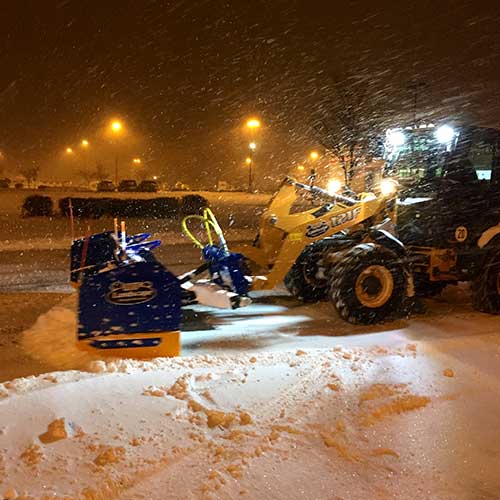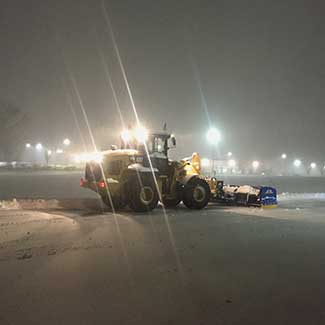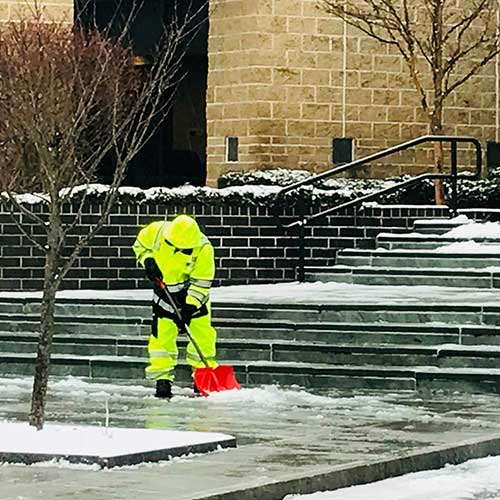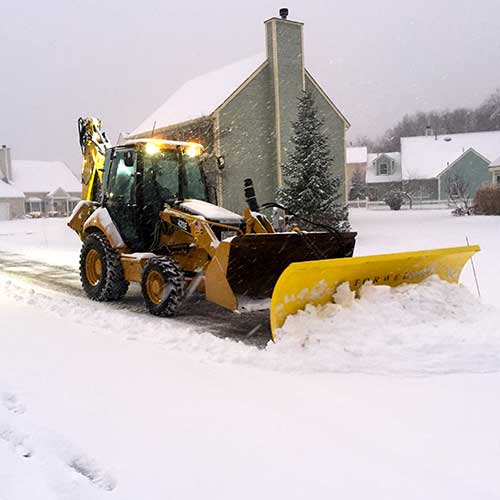Premier Natick
Snow Removal Company
Looking for a Natick Snow Removal Company?
Are you a Business Owner? Property Manager? Or maybe someone just looking for more information on a top notch Natick snow removal company.
You’re in the right place…
DO YOU HAVE THESE PROBLEMS:
• Not happy with existing snow plowing contractor?
• New business owner?
• Accepting new bids for existing property?
• In need of immediate snow removal services?
• Need bigger equipment or team to manage your properties?
MF Landscape & Design‘s commercial snow removal services have helped thousands of business owners, property managers, and other individuals in Natick, MA and the surrounding communities plow, sand, salt, shovel, and maintain their parking lots, walkways, and stairs. We understand the liability and know how to prevent potential problems for you, your customers, and your employees.
After some research, we’re confident you’ll find us to be the right ice and snow management company to handle your snow removal needs.
Why Choose
MF Landscape & Design as your Commercial Snow Removal Company in Natick, MA?
In short… Because we have a reputation for quality work at a fair price. Our customer service is second to none. Our team is always responsive, courteous, friendly, and respectful.
At MF Landscape and Design, we do it all! From conception through to completion, we handle every aspect of snow removal, snow hauling, ice management, as well as shoveling of walkways and steps.
With MF Landscape & Design, you’ll receive:
- Quality workmanship that is guaranteed to last
- Work form licensed professionals who are honest and hardworking
- Dependable service that is completed on time and on budget
- Financing options to help fund your yard and garden projects
- Free estimates and a fully insured crew
To review the creativity of our design and the quality of our craftsmanship, simply take a look at our Photo Gallery. Our decades worth of landscaping projects speak for themselves! From custom landscape designs to planting projects, patios, stonework, snow removal, and more — You can trust your yard or business property to our team of experts.
Benefits of
Snow Removal:
Prevent Accidents
Use Specialized Equipment
Prevent Lost Income
Safety and Liability
24-hour Service
Photo Gallery of our Snow Removal Company at work
Snow Removal, Plowing, and Salting Services Avoids Loss Of Business and Liability
We have the equipment, knowledge, and skill necessary to expedite the process so that, whether you own a storefront, a manufacturing facility, or an office building, your commercial property won’t be hindered by heavy snowfall and ice. Fully licensed, insured and always furthering our education to most efficiently serve our clients. Professionally seasoned with over a decade of in-the-field, hands-on experience.
Best Time To Contact A Snow Removal Company?
Now! Today!!
★★★★★
Top-Rated Landscaper
Focused On Service And Delivering Quality
Welcoming New Customers From
Natick, Massachusetts
More About Natick, MA
Natick ( NAY-tik) is a town in Middlesex County, Massachusetts, United States. It is near the center of the MetroWest region of Massachusetts, with a population of 37,006 at the 2020 census. 10 miles (16 km) west of Boston, Natick is part of the Greater Boston area. Massachusetts’s center of population was in Natick at the censuses of 2000-2020, most recently in the vicinity of Hunters Lane.
The name Natick comes from the language of the Massachusett Native American tribe and is commonly thought to mean “Place of Hills.” A more accurate translation may be “place of searching,” after John Eliot’s successful search for a location for his Praying Indian settlement.
Natick was settled in 1651 by John Eliot, a Puritan missionary born in Widford, England, who received a commission and funds from England’s Long Parliament to settle the Massachusett Indians called Praying Indians on both sides of the Charles River, on land deeded from the settlement at Dedham. Natick was the first of Eliot’s network of praying towns and served as their center for a long time. While the towns were largely self-governing under Indian leaders, such as Waban and Cutshamekin, the praying Indians were subject to rules governing conformity to Puritan culture (in practice Natick, like the other praying towns, combined both indigenous and Puritan culture and practices). Eliot and Praying Indian translators printed America’s first Algonquian language Bible. Eventually, the church in Natick was led for several decades by an indigenous pastor, Rev. Daniel Takawambait.
The colonial government placed such settlements in a ring of villages around Boston as a defensive strategy. Natick was the first and best documented settlement. The land was granted by the General Court as part of the Dedham Grant.
After a period of expansion and little focus on evangelism, Reverend John Robinson told the New Englanders to prioritize missionary work over growth, “the killing of those poor Indians….How happy a thing it had been if you had converted some before you had killed any.” Chastened in the wake of the Mystic Massacre which occurred during the Pequot War, sincere efforts at evangelizing began. A school was set up, a government established, and the Indians were encouraged to convert to Christianity. In November 1675, during King Philip’s War, the Natick Indians were sent to Deer Island. Many died of disease and cold, and those who survived found their homes destroyed. The Indian village did not fully recover, and the land held in common by the Indian community was slowly sold to white settlers to cover debts. By 1785, most of the Natick Indians had drifted away. After King Philip’s War, Elliot’s and a few other missionaries’ opposition to the executions and enslavement of Indians were eventually silenced by death threats.
In 1775, both European and Indian citizens of Natick participated in the battles of Lexington, Concord and Bunker Hill, as well as serving in the Continental Army. The names of Natick’s Praying Indian soldiers are memorialized on a stone marker, along with all of Natick’s Revolutionary War veterans, on a stone marker on Pond Street, near downtown Natick.
The town was incorporated in 1781. Henry Wilson, a U.S. senator who became the 18th Vice President of the United States (1873–1875), lived most of his life in Natick as a shoemaker and schoolteacher known as the “Natick Cobbler” and is buried there. He is the namesake of one of Natick’s middle schools.
Though Natick was primarily a farming town, the invention of the sewing machine in 1858 led to the growth of several shoe factories. The business flourished and peaked by 1880, when Natick, with 23 operating factories, was third in the nation in the quantity of shoes produced. The shoes made in Natick were primarily heavy work shoes with only one or two companies making lighter dress shoes. Natick was famous for its brogan (shoes), a heavy ankle-high boot worn by soldiers in the American Civil War.
The wound core for a more resilient baseball was developed by John W. Walcott and combined with the figure-eight stitching devised by Colonel William A. Cutler. It was manufactured by the firm of H. Harwood & Sons in their factory, the world’s first plant for the manufacture of baseballs. In 1988 H. Harwood & Sons was converted into baseball factory condominiums.
In 1874, a fire in downtown Natick demolished 18 business blocks, two shoe factories, the Town Hall, Natick’s only fire engine house and the Congregational Church, as well as many private homes. Though there were no deaths, the loss of property was greater in proportion to the town’s wealth than the Great Chicago Fire of 1871. In 1875, Natick’s new Central Fire Station was completed on Summer Street and opened with grand ceremony on the same city block where the fire was first discovered. The Central Fire Station is now the home of The Center for Arts in Natick (TCAN), a private nonprofit performing arts center.
In 1891, a team from the town fire department won “The World’s Hook and Ladder Championship”, a competition between the fire departments of four area towns. The victory gave the town its nickname “Home of Champions”.
Miles 8 through 12 of the Boston Marathon run through Natick on Patriots’ Day every year along Route 135/Central St., and thousands of residents and visitors line the road to watch.
According to the United States Census Bureau, the town has an area of 16.0 square miles (41 km), of which 15.1 square miles (39 km2) is land and 1.0 square mile (2.6 km) is water. The total area is 7.04% water, including Lake Cochituate and Dug Pond.
Natick borders Wellesley, Wayland, Weston, Framingham, Sherborn and Dover.
Natick Center, also known as Downtown Natick, is at the intersection of Central Street and Main Street and serves as the town’s civic and cultural hub.
Many public services and public land use are downtown. Municipal buildings like the Natick Town Hall, Natick Fire Department, Natick Police Department and Morse Institute Library are there, along East Central Street. Also directly downtown is the Natick Town Common, where many town events and community activities are held. In the 1990s new downtown construction of a town hall, fire/police station, and enlargement to the library gave the downtown a fresh new look. New municipal buildings exist alongside several historic buildings and churches, the restored Central Fire House, several banks, restaurants and small businesses.
In 2012 the Massachusetts Cultural Council voted unanimously to make Natick Center one of the newest state-designated cultural districts, the tenth district to win this designation from the Commonwealth of Massachusetts. The Cultural Districts Initiative is designed to help communities attract artists and cultural enterprises, encourage business and job growth, expand tourism, preserve and reuse historic buildings, enhance property values, and foster local cultural development. Natick Center Cultural District is anchored by The Center for Arts in Natick, Morse Institute Library and the Natick Common.
South Natick, known for its scenic nature, is where the Native American settlers first arrived and began the town on the shores of the Charles River. Housing developers like Martin Cerel lived in South Natick, and thus refrained from building major tract neighborhoods in this part of town.
Most South Natick residents consider themselves to have a strong, separate cultural identity from the rest of Natick. It is the only community in Natick that can be separately addressed officially via the US Postal Office, and street signage such as a sign along Route 16 coming from Wellesley communicates arrival in “So. Natick.”
East Natick is a community of Natick along Oak Street and at the intersection of Oak Street and Worcester Street. Notable landmarks include Jennings Pond, the Industrial Park on Oak St North, and the Lilja School. Longfellow Health Club, which features a gym, pool, and tennis courts, is in East Natick off Oak St. in the Industrial Park. The stretch of Route 9 in East Natick as one heads into Wellesley contains a multitude of ever-changing retail businesses.
West Natick is a large section of Natick that borders the town of Framingham. The Natick Mall, as well as the strip mall called Sherwood Plaza with its office Industrial Park behind, are considered to be the commercial hub of West Natick. In addition to its retail development, post World War II housing developments like Westfield, Pelham, and Sherwood as well as the National Guard depot and a golf course on Speen St brought many people to this part of town.
There are many businesses in West Natick along West Central Street as well as another MBTA Commuter Rail station in addition to the one downtown. The area in West Natick, along Route 135 is the most densely populated section of town, with its thousands of condominiums and apartments clustered across the street from the train station.
Natick is a small town, and thus, the various sections of tract development homes are considered neighborhoods. These were houses built by several contractors in the late 1940s until the late 1950s. Listed here, are a few of these sections.
One of the earliest post World War II developments in West Natick, the homes are colonial in style, with street names reminiscent of the Robin Hood legend. The homes were built in 1948 and the neighborhood remains popular due to the fact that there’s no through traffic, and most of the houses have been enlarged with additions.
Walnut Hill is a neighborhood north of downtown. It is known for the private boarding school Walnut Hill School for the Arts, as well as many Victorian era houses lining Walnut and Bacon Streets.
The Wethersfield area of Natick is a residential neighborhood north of Route 9. It is a typical 1950s development of Campanelli ranch houses, and remains popular with first-time home buyers due to the relatively inexpensive slab-style houses. This area includes Drury Lane and all connecting roads within the boundaries of route 9, Pine Street, and Route 27.
South of Route 9, this section began as a summer vacation area, with tiny cottages surrounding Jennings Pond. Over the years, some houses were enlarged, but the area remains quaint and quiet with no thru traffic. On the westerly side of South Oak is a neighborhood of Cape style houses with streets named after World War II Generals.
North of Route 9, other developments of small Cape-style homes were built in the early and mid-1950s and were popular with first-time home buyers due to their affordability. As is happening throughout the region, the capes are getting large additions or replaced by much larger homes. There are two Industrial Parks along north Oak St that contain office buildings on one side of the road and larger warehouses on the eastern side.
Just south of the Natick Common, Cottage Street begins what is commonly called Little South, named so because of its proximity to South Natick. Little South nomenclature extends to the east portions of Everett Street, down to Eliot St. Homes along Cottage St. were primarily built in the early 1950s and are mostly modest and well-maintained. The best-known landmarks in Little South are a WWII monument dedicated to the fallen soldiers from Natick, and The Tobin School, a private daycare and elementary school that has two large buildings off of Cottage St. Everett St. has larger farm homes situated on generous lots. Eliot St., which runs parallel to the Charles River, has some of Natick’s oldest homes. Just before South Natick begins, there is a Virgin Mary statue on a large rock on the south side of the Charles River, enveloped by pine trees.
As of the census of 2010, there were 32,786 people, 13,080 households, and 8,528 families residing in the town. The population density was 2,132.9 inhabitants per square mile (823.5/km2). There were 13,368 housing units at an average density of 886.3 per square mile (342.2/km). The racial makeup of the town was 85.4% White, 2% African American, 0.1% Native American, 7.2% Asian, 0.0% Pacific Islander, 0.5% from other races and 2% from two or more races. Hispanic or Latino of any race were 3% of the population.
There were 13,080 households, out of which 30.3% had children under the age of 18 living with them, 54.5% were married couples living together, 8.2% had a female householder with no husband present, and 34.8% were non-families. Of all households, 28.3% were made up of individuals, and 9.8% had someone living alone who was 65 years of age or older. The average household size was 2.42 and the average family size was 3.02.
In the town, the population was spread out, with 23.0% under the age of 18, 5.1% from 18 to 24, 34.3% from 25 to 44, 23.3% from 45 to 64, and 14.3% who were 65 years of age or older. The median age was 38 years. For every 100 females, there were 89.7 males. For every 100 females age 18 and over, there were 85.3 males.
According to a 2007 estimate, the median income for a household in the town was $61,855, and the median income for a family was $85,056. Males had a median income of $51,964 versus $41,060 for females. The per capita income for the town was $36,358. About 1.7% of families and 2.8% of the population were below the poverty line, including 2.4% of those under age 18 and 5.3% of those age 65 or over.
Natick is surrounded, on three sides, by five of the eleven most affluent towns in Massachusetts with Wayland to the north, Weston to the northeast, Wellesley to the east, Dover to the southeast, and Sherborn to the southwest.
Source:
Companies based in Natick include Cognex Corporation and MathWorks.
Natick has representative town meeting form of government (consisting of 180 members) with a Board of Selectmen and a Town Administrator. The members of the Board and the dates their terms end are (as of March 2019):
The town is part of the Massachusetts Senate’s Norfolk, Bristol and Middlesex district.
Mismanagement of Middlesex County’s public hospital in the mid-1990s left the county on the brink of insolvency, and in 1997 the Massachusetts legislature stepped in by assuming all assets and obligations of the county. The government of Middlesex County was officially abolished on July 11, 1997. The sheriff and some other regional officials with specific duties are still elected locally to perform duties within the county region, but there is no county council or commissioner. Communities are now granted the right to form their own regional compacts for sharing services.
These are the remaining elected officers for Middlesex County:
The Natick Public School District operates the following schools:
Natick Center station, in the downtown area, is served by the MBTA Commuter Rail Framingham/Worcester Line.
Bus service is provided in Natick by the MetroWest Regional Transit Authority.
Natick was the setting for Harriet Beecher-Stowe’s 1869 fictional novel Oldtown Folks. The novel is based on her husband’s childhood in Natick, and it accurately details town landmarks, ministers, and inhabitants despite renaming the location to Oldtown. Beecher-Stowe is best known for writing abolitionist fiction novel Uncle Tom’s Cabin.
Natick appears on the Family Guy episode “Da Boom” when the family sets out to the town after Peter reveals that there is a Twinkie factory there (Natick did contain a Hostess factory until 2007 when the Natick Mall expanded into the collection). He eventually starts a town on the ruins of the community, naming it New Quahog.
To solvers of crossword puzzles such as those of The New York Times and the Los Angeles Times, natick (as coined by Michael Sharp, alias Rex Parker) refers to any square a solver cannot fill in correctly without guessing because the solver does not know either entry that passes through it (and there are at least two letters that are reasonable guesses). Such entries are generally proper nouns.
Scenes included in the 2013 American drama film Labor Day (film) starring Kate Winslet, Josh Brolin and Tobey Maguire were filmed in Natick, at locations including The Center for Arts in Natick and Park Street Ice Cream.
Natick appears in the 2015 video game Fallout 4, which is set in the greater Boston area (referred to in the game as The Commonwealth).
Part of South Natick made an appearance in the Oscar-nominated movie Knives Out. While filming on location, the project had the code name “Morning Bell”. Other scenes were shot in surrounding towns such as Wellesley, Framingham, and Waltham.
In April 2019 Chris Evans was in Natick filming an upcoming TV series, Defending Jacob. The production was seen filming on the Natick Common, Park Street, and at Park Street Ice Cream. The ice cream shop was temporarily converted into “K.D. Scoops” for the filming. Many Natick residents crowded around in hopes of getting a glimpse of Evans. Photos were taken of him and his co-star sitting on a bench on the commons as well as inside and outside Park Street Ice Cream. Defending Jacob released on Apple TV+ on April 24, 2020.
The characters in the 2021 visual novel Emily is Away <3 by Kyle Seeley live in Natick and attend Natick High School.
Ice Management & Sanding
Many business owners believe that going outside to occasionally spread salt around is sufficient to keep their pathways safe. Controlling ice is not an easy thing to do when weather conditions are severe like they often are in Massachusetts. Effective ice control requires the experience gained from over a decade of snow and ice management. A fleet of heavy equipment and a large group of full time and seasonal employees are all prepared to mobilize 24/7.
Snow Shoveling And Walkway De-icing
When you consider a commercial snow removal service, you may be thinking snow plows, and other heavy-duty equipment rolling out to clear expansive parking lots and roadways – but your sidewalks and entryways will also need attention. MF Snow Management is a full service enterprise. We are equipped to handle the big jobs, but we also have machinery that is particularly functional for the smaller ones. We have snow blowers that we use to remove light accumulations, and others for deep snow removal.
Talk to an Expert
We understand that sometimes you just want to talk before scheduling a consultation.
Our team will gladly answer any of your questions or help you with any of your concerns.
Call (508) 404-4819 now!
Snow Removal For These Types Of Businesses
- Retail Stores
- Gas Stations
- Movie Theatres
- Grocery Stores
- Malls
- Industrial Offices
- Restaurants
- Apartment Complexes
- Multi-use Commercial buildings
- Parking Lots
- Medical Offices
- Hospitals
- Health Care Facilities
- Gyms
- Car Dealerships
- And More!
Don’t see your business type on the list? No Problem! If your business needs help with snow plowing, give us a call and we’d be happy to come to take a look at your property and give you a fair estimate to manage things for the entire winter.














